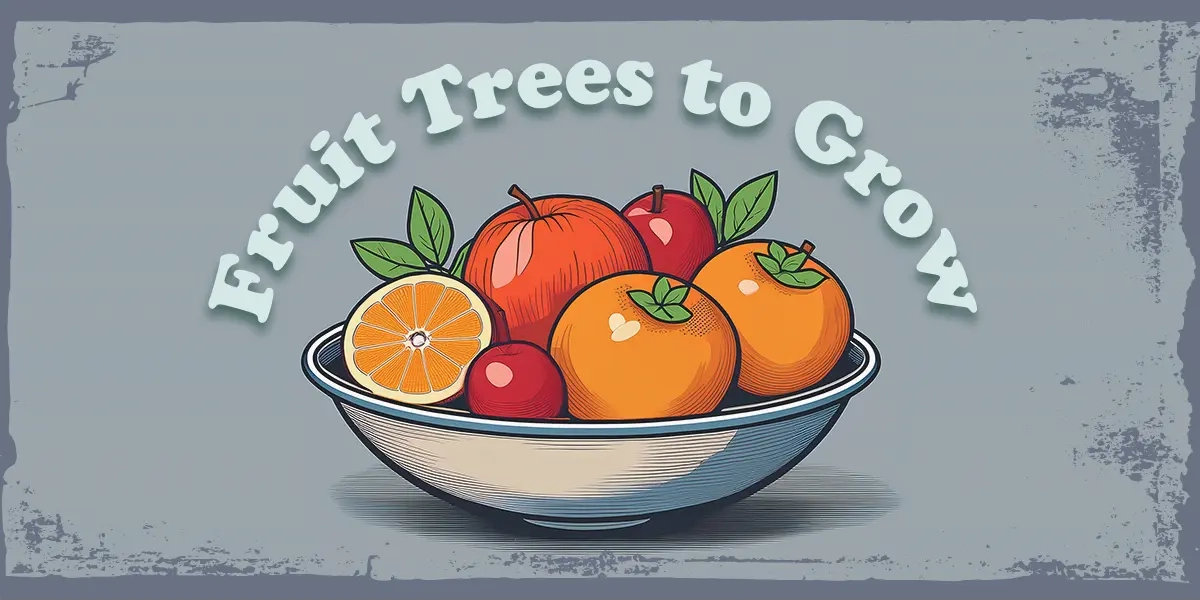Got fruit? You should, if you live in LA.
California accounts for 75% of the nation’s total fruit output. Most of that fruit grows in the Central Valley, but your SoCal yard has a similar favorable climate, fertile soil, and a long growing season. What’s stopping you from planting limes, lemons, or pomelos?
Limes, lemons, and many other fruits will ripen only on the tree. Once picked, the ripening process ceases. That’s why a fully ripe fruit picked fresh will always be sweeter and juicier than anything you can buy.
Superior flavor is just one benefit of home fruit tree gardening. Others include:
- Cost-savings: Organic fruits at the store may cost double the price of chemically treated fruits, and then they’ll go bad in the crisper if you don’t consume them promptly.
- Health benefits: Homegrown fruits contain higher levels of vitamins and antioxidants since they don’t travel far to reach your plate. Plus, you control the use of pesticides and fertilizers, ensuring your produce is free from harmful chemicals.
- Mental and emotional well-being: Gardening reduces stress and anxiety. It provides a sense of accomplishment and pride when you see your trees mature and bear delicious fruit.
- Sustainable living: No transport or packaging = a much reduced carbon footprint. And you can take your eco-warrior journey further by composting fruit scraps into nutrient-rich organic soil.
- Physical activity: Gardening is a low-impact exercise that improves endurance, flexibility, and strength. Your daily dose of Vitamin D from sunlight may also help you sleep better!
So now that you’re raring to grab a shovel and get started, which fruit trees should you cultivate?
1. Lemon Tree
Home-grown lemons have a hint of sweetness you’ll never find in store-bought varieties. Native to Asia, lemons thrive in Mediterranean-style climates. The trees require little maintenance and produce fruit year-round.
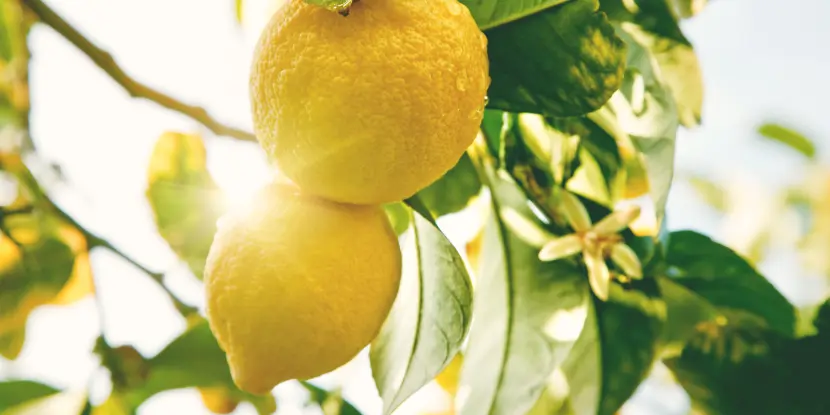
Three lemons again? You always win a prize when you grow the versatile citrus fruit at home.
At-a-Glance
- Light: Full sun (6–8 hours daily)
- Temperatures: Withstands heat; frost-sensitive
- Soil: Well-draining with a pH between 5.5–6.5
- Fruit Bearing Season: Year-round varieties include Meyer and Eureka
- Height and Spread: 10–20 ft (standard); 3–4 ft (dwarf)
Care
- Deep but infrequent watering
- Fertilize with a citrus-specific fertilizer 3–4 times a year
- Prune to shape and maintain airflow
2. Avocado Tree
The ever-jovial Aztecs compared the avocado fruit to male anatomy.
The Central American avocado tree is equally at home in Southern California. It’s hardy and fast-growing, and will give you access to an endless supply of fresh guacamole.
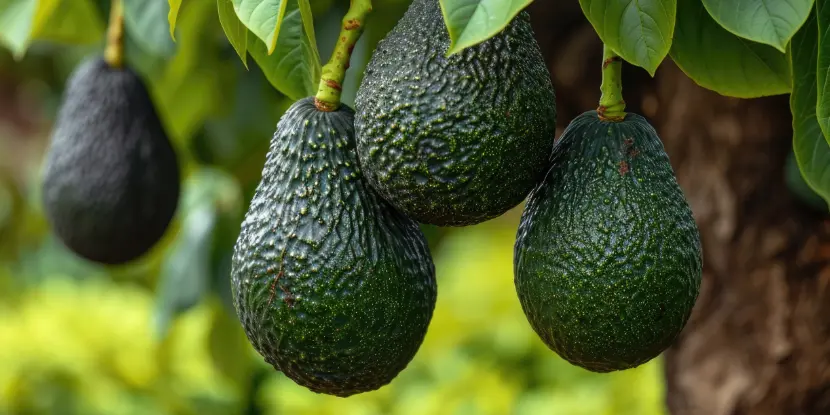
The Aztecs had a “funny” name for the distinctive avocado fruit.
At-a-Glance
- Light: Full sun to partial shade
- Temperatures: Prefers temperatures above 60°F; frost can damage young trees
- Soil: Rich, well-draining soil with pH around 6–7
- Fruit Bearing Season: Spring through late summer, depending on the variety
- Height: 30–40 ft (standard); 6–10 ft (dwarf)
- Spread: 20–30 ft (standard); 6–10 ft (dwarf)
Care
- Water deeply every other week
- Plant multiple varieties if you want optimal pollination (e.g., Haas and Fuerte)
- Mulch heavily to maintain moisture
3. Fig Tree
Figs are drought-tolerant, highly productive, and require minimal care. They’re among the earliest domesticated crops in human history, dating back 9,000 years to the Mediterranean region.
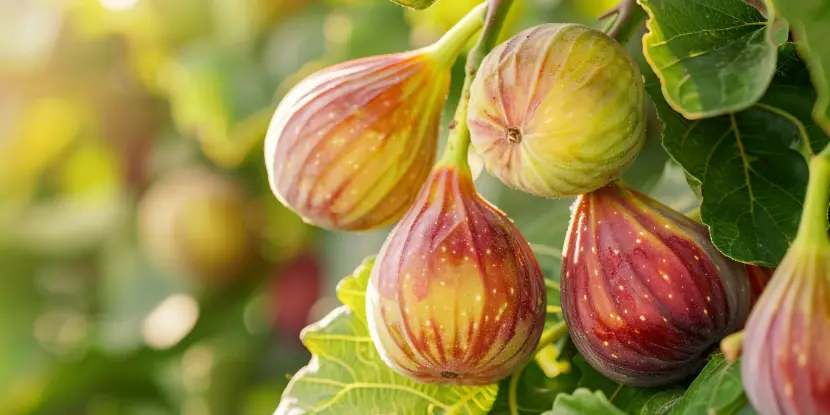
Figs are one of the oldest cultivated fruit trees.
At-a-Glance
- Light: Full sun (6–8 hours)
- Temperatures: Can tolerate temperatures above 85°F but struggles in hard frosts
- Soil: Loamy, well-draining soil with a pH between 6–8
- Fruit Bearing Season: Early summer to fall
- Height: 10–30 ft (standard); 3–4 ft (dwarf)
- Spread: 15–30 ft (standard); 3–4 ft (dwarf)
Care
- Requires less water once established
- Prune annually during winter dormancy to maintain size
- Watch for suckers at the base and remove them
4. Orange Tree
Many California fortunes were built on the orange tree, a Southeast Asia native. Even today, after most LA-area groves have disappeared, California produces over 72% of the national orange harvest.
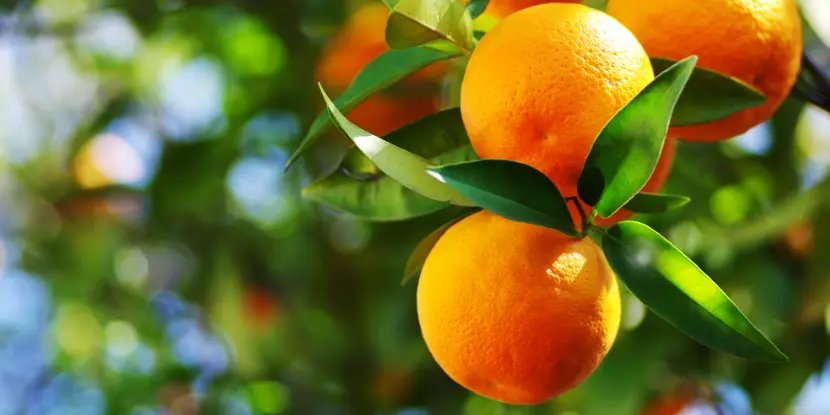
Florida gets the PR, but California produces over 72% of the national orange harvest.
At-a-Glance
- Light: Full sun
- Temperatures: Tolerates heat and mild cold (down to 27°F)
- Soil: Well-drained, slightly acidic soil (6–7 pH)
- Fruit Bearing Season: Winter into early spring for varieties like Navel
- Height: 20–30 ft
- Spread: 20–40 ft
Care
- Water deeply but infrequently
- Fertilize during the growing season with a nitrogen-rich fertilizer
- Watch for common pests like aphids or scale
- Prune for shape and to increase air circulation
5. Pomegranate Tree
The pomegranate hails from modern-day Iran and northern India, where cultivation dates back 4,000 to 5,000 years. Pomegranate trees are drought-tolerant and highly resilient, making them perfect for the Southern California climate.
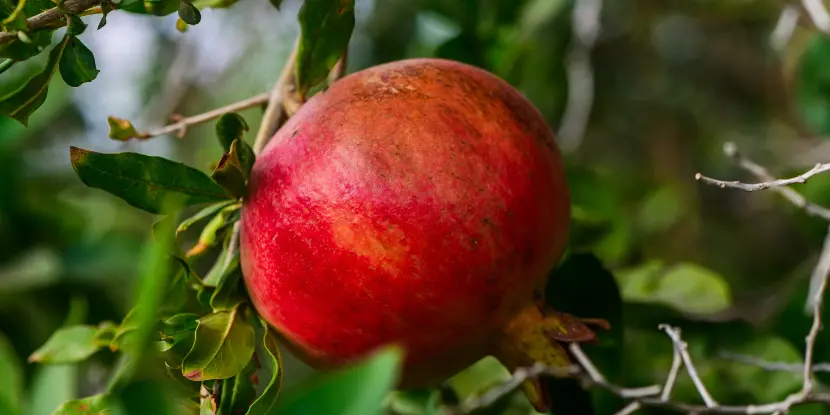
Pomegranate trees thrive in hot and dry conditions.
At-a-Glance
- Light: Full sun
- Temperatures: Thrives in temperatures between 40–90°F
- Soil: Well-draining soil; tolerates slightly alkaline conditions
- Fruit Bearing Season: Late summer through fall
- Height: 6–20 ft (standard); ~3 ft (dwarf)
- Spread: 4–15 ft
Care
- Water sparingly; these trees thrive in arid soil
- Prune in late winter to remove suckers and open the canopy
- Apply organic mulch to retain moisture
6. Apple Tree
Johnny Appleseed never made the trek to California, but Spanish missionaries did, and brought the apple with them. This Central Asian fruit tree needs chill hours to thrive, but with the right variety, you can enjoy apples straight off the tree.
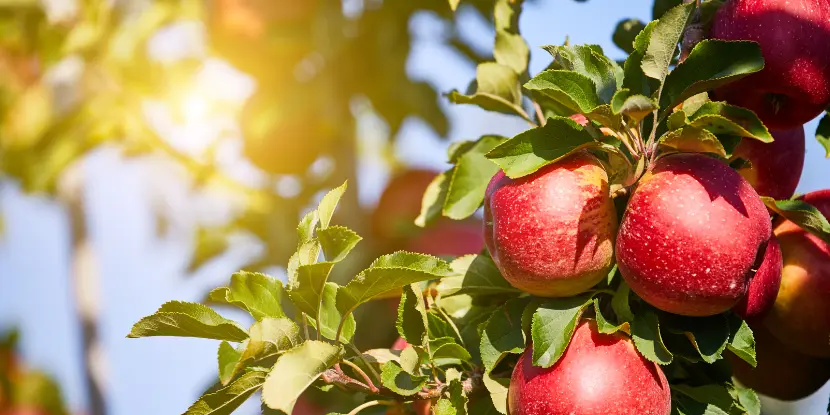
Some apple varieties grow exceptionally well in Southern California, even in warmer counties like San Bernardino. Johnny Appleseed would be proud.
At-a-Glance
- Light: Full sun
- Temperatures: Requires winter chill hours (select low-chill varieties like Anna or Dorsett Golden)
- Soil: Loamy soil with good drainage, pH between 6–6.8
- Fruit Bearing Season: Early summer to early fall, depending on the variety
- Height: 15–30 ft (standard); 6–10 ft (dwarf)
- Spread: 15–30 ft (standard); 6–10 ft (dwarf)
Care
- Keep soil moist but not soggy
- Fertilize during the growing season
- Thin fruit to maintain health and increase size
Fun fact: Oak Glen in San Bernardino County is a popular destination for apple picking and agritourism.
7. Peach Tree
Peaches are excellent for smaller gardens due to their modest size and high yield. Southern California’s mild climate closely mimics the peach’s native environment in China.
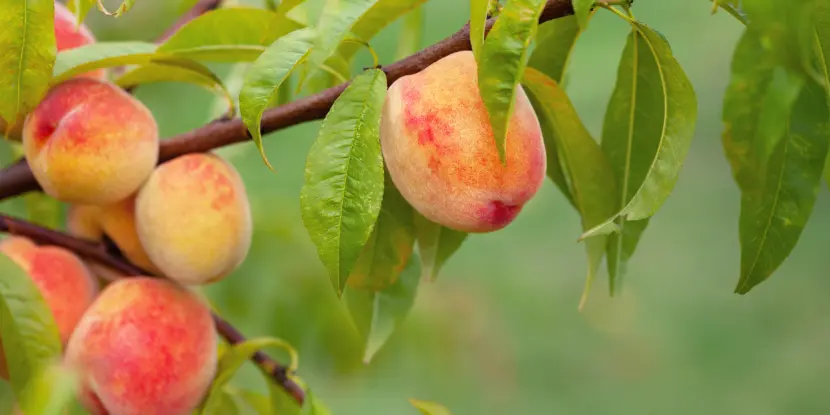
California is more of a Peachtree State than Georgia, since it grows the overwhelming bulk of peaches in the USA.
At-a-Glance
- Light: Full sun
- Temperatures: Thrives in temperatures up to 75–90°F; select low-chill varieties
- Soil: Sandy, well-draining soil (pH 6–7)
- Fruit Bearing Season: Summer months
- Height: 15–25 ft (standard), 6–8 ft (dwarf)
- Spread: 15–25 ft (standard), 5–7 ft (dwarf)
Care Requirements
- Prune yearly to shape the tree and remove deadwood
- Requires regular irrigation, especially during fruiting season
- Watch for leaf curl fungus
8. Persimmon Tree
The persimmon has been farmed for over 2,000 years in China and Japan and was introduced to California in the mid-1800s.
Have you ever enjoyed a Fuyu Persimmon in a salad? It’s to die for!
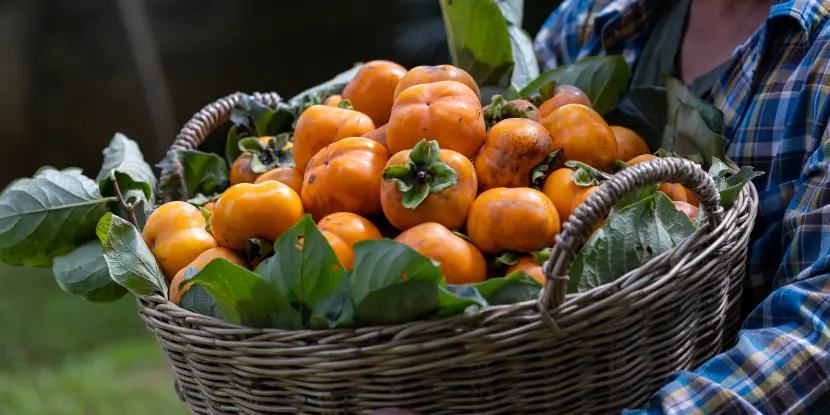
A bountiful harvest of Fuyu Persimmons. Try them in salads!
At-a-Glance
- Light: Full sun
- Temperatures: Can tolerate temperatures as low as 0°F
- Soil: Well-drained, loamy soils with a pH between 6.0 and 7.5
- Fruit Bearing Season: In the fall, between September and November
Care
- Regular watering, especially during dry periods
- Apply a balanced fertilizer in early spring before new growth begins
- Remove dead or diseased branches and shape the tree as desired
- Monitor for issues like scale insects or leaf spot
9. Lime Tree
Traders carried the seeds of Southeast Asian limes to the Mediterranean, where they later spread to the Americas. Limes ripened on the tree will have the tiniest trace of sweetness.
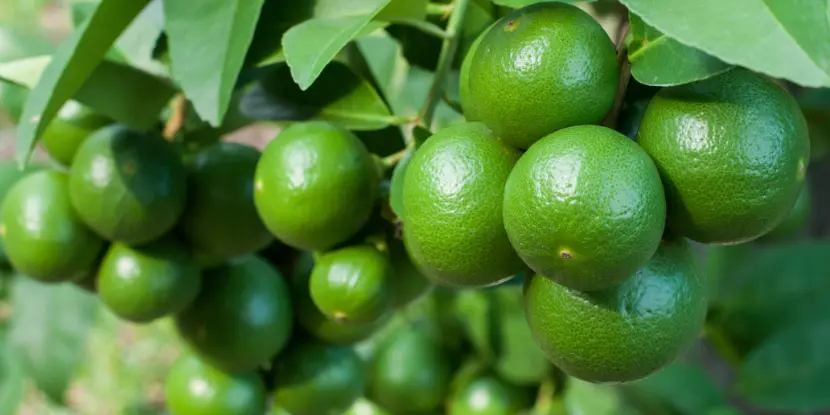
Is your guacamole too bland? Give it an extra shot of lime juice for zest.
At-a-Glance
- Light: Full sun
- Temperatures: Prefers 50–100°F; temperatures below 32°F can damage or kill the tree
- Soil: Well-drained, loamy soils with a pH between 6.0 and 7.5.
- Fruit Bearing Season: Late winter or early spring
- Height: 10–20 ft (standard); 6–10 ft (dwarf)
- Spread: 5–15
Care
- Water regularly, allowing the soil to dry slightly between waterings
- Apply a balanced citrus fertilizer every 4 to 6 weeks during the growing season
- Prune to remove dead or diseased branches and to maintain shape and size
- Monitor for aphids, scale insects, and leaf miners
10. Guava Tree
Guava trees are native to southern Mexico and Central America. They were introduced to California around 1847, with cultivation documented in Los Angeles by 1850.
Home-grown guavas bear only a faint resemblance to commercial guavas, which are picked early and transported great distances. Home-grown guavas are rich, fragrant, and flavorful, unlike their waxy commercial counterparts. As a bonus, compact guava trees are suitable for smaller yards.
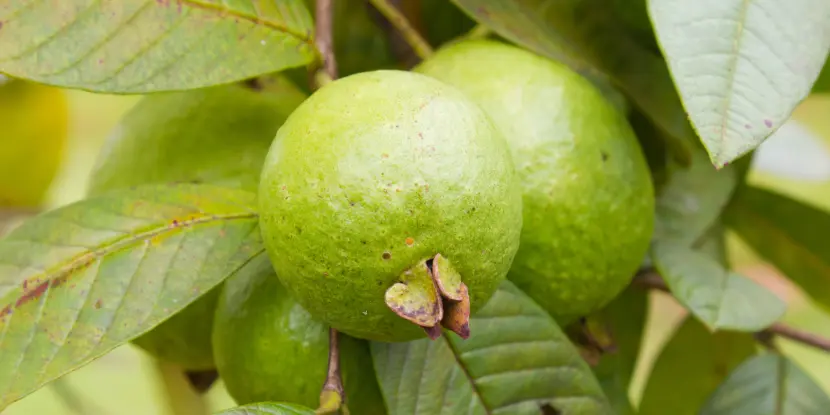
Guavas are gweat when you gwow them yourself, unlike their waxy commercial counterparts.
At-a-Glance
- Light: Full sun
- Temperatures: Prefers 65–90°F; sensitive to frost
- Soil: Well-drained, loamy soils with a pH between 6.0 and 7.5.
- Fruit Bearing Season: Late summer to early fall
- Height: 10–30 ft (standard); 3–5 ft (dwarf)
- Spread: 10–20 ft (standard); 3–5 ft (dwarf)
Care
- Water young trees regularly; established trees need less watering
- Apply a balanced fertilizer 3 to 4 times during the growing season
- Prune guava trees in early spring for better airflow and fruiting
- Monitor for pests such as aphids and fruit flies
11. Grapefruit Tree
This natural hybrid from the West Indies offers a refreshing balance of sweet and bitter citrus flavors. The grapefruit tree flourishes in Southern California with sufficient sunlight and well-draining soil.
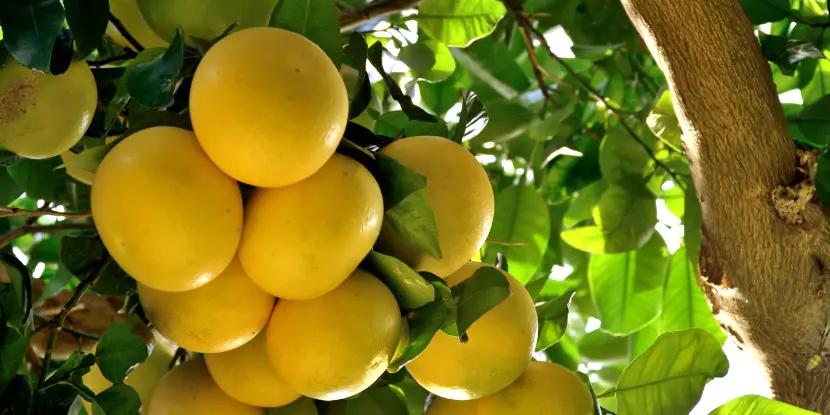
Juice, anyone? The grapefruit is a favorite of health-conscious gardeners.
At-a-Glance
- Light: Full sun
- Temperatures: Prefers 60–85°F; protect from frost
- Soil: Loamy, well-draining soil with a pH of 6.0–7.0
- Fruit Bearing Season: Winter through spring
- Height: 15–30 ft (standard); 5–8 ft (dwarf)
- Spread: 10–25 ft (standard); 5–8 ft (dwarf)
Care
- Needs regular irrigation during dry periods
- Fertilize twice a year with a citrus blend
- Thin overcrowded branches to boost air circulation
12. Plum Tree
Plum trees originated over 2,000 years ago around the Caucasus and the Caspian Sea. Varieties like the ‘Santa Rosa’ plum are particularly well-suited to Southern California, offering delicious fruit and ornamental beauty.
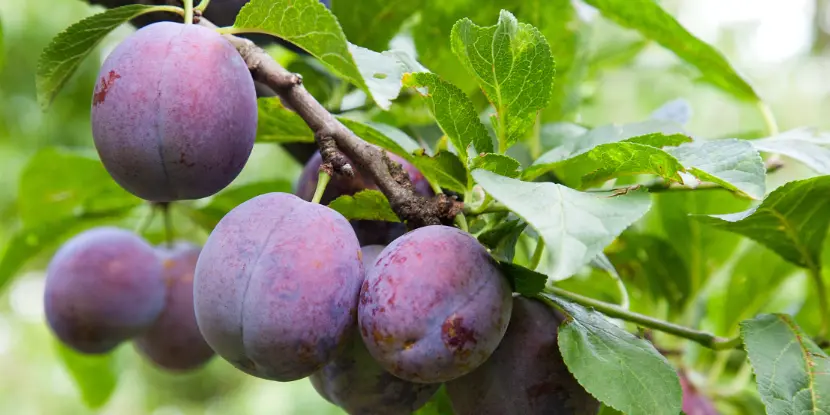
Little Jack Horner would be pleased to pick a ripe plum off the tree.
At-a-Glance
- Light: Full sun
- Temperatures: Requires winter chill for dormancy, but is sensitive to extreme cold or heat
- Soil: Well-drained, loamy soil with a pH between 6.0 and 7.0
- Fruit Bearing Season: Mid to late summer
- Height: 15–30 ft (standard); 4–6 ft (dwarf)
- Spread: 10–20 ft (standard); 4–8 ft (dwarf)
Care
- Prune in late winter for shape and airflow
- Water deeply but infrequently
- Prune off dead or damaged branches
- Apply organic fertilizer or well-aged manure in early spring
13. Cherry Tree
While Southern California’s climate may not provide the consistent cold winters some cherry varieties prefer, selecting low-chill varieties and providing appropriate care can still allow for successful cultivation.
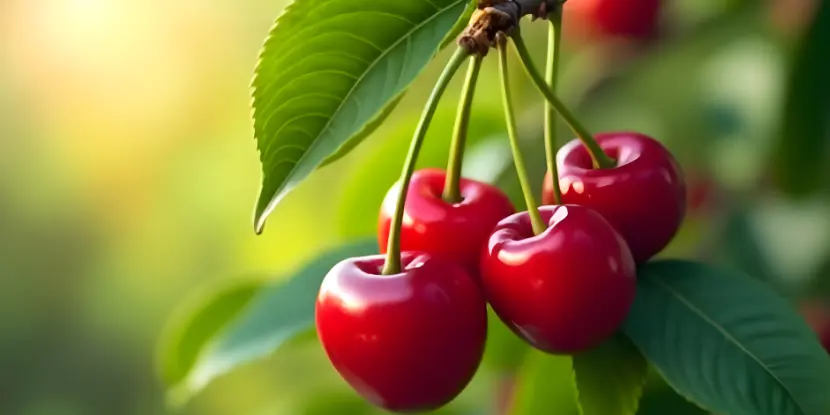
Cherry trees need chill hours to fruit, but some varieties do well in Southern California’s warm climate.
At-a-Glance
- Light: Full sun (or morning sun and afternoon shade in hot inland areas)
- Temperatures: Performs best in 45–85°F; requires chill hours for fruiting
- Soil: Well-draining, loamy soil with a pH of 6.0–7.0
- Fruit Bearing Season: Late spring to early summer
- Height: 5–35 ft (standard); 3–8 ft (dwarf)
- Spread: 15–25 ft (standard); 3–8 ft (dwarf)
Care
- Prune in late winter to early spring to maintain tree health and shape
- Ensure consistent watering for healthy fruit development
- Protect ripe fruit with netting to deter birds
14. Tangerine Tree
The tangerine’s name derives from Tangier, Morocco, a port from which they were first shipped to Europe. The tree originated in Southeast Asia. Southern California’s warm, dry summers and mild winters are ideal for tangerine cultivation, making them a popular choice for home gardens.
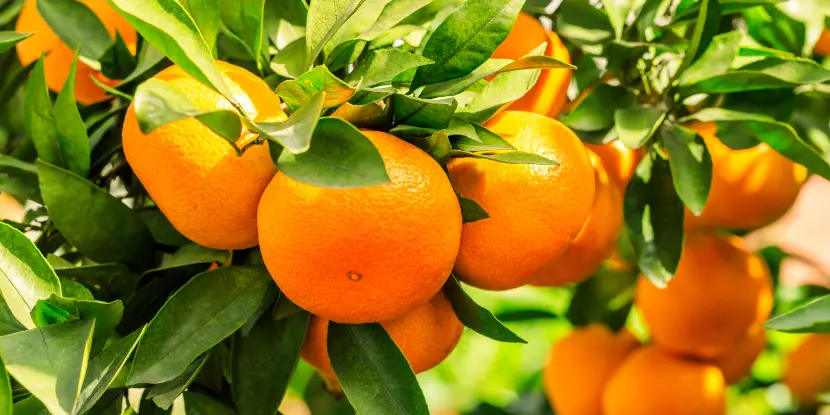
Tangerines get their name from the port of Tangier in modern-day Morocco.
At-a-Glance
- Light: Full sun
- Temperatures: 55–85°F; can tolerate brief periods of cold but are sensitive to frost
- Soil: Well-drained, sandy loam soil with a pH between 5.5 and 6.5
- Fruit Bearing Season: Late fall to early winter
- Height: 10–15 ft
- Spread: 8–10 ft
Care
- Young trees need regular watering to establish roots
- Apply a balanced citrus fertilizer in early spring and again in late summer
- Prune annually during late winter or early spring
- Regularly inspect for pests like aphids and diseases like citrus canker
15. Pomelo Tree
Give a grapefruit a dose of growth hormone, and what do you get? It might be the pomelo, a larger citrus cousin with pink or yellow flesh and a pale greenish-yellow rind.
Pomelo trees are deciduous, meaning they lose their leaves seasonally. They produce large, fragrant white flowers that develop into spherical fruits ranging from grapefruit size to as big as a basketball.
Pomelo fruits are milder, sweeter, and drier than the juicier grapefruit. You might serve their peeled sections in fruit platters or salads.
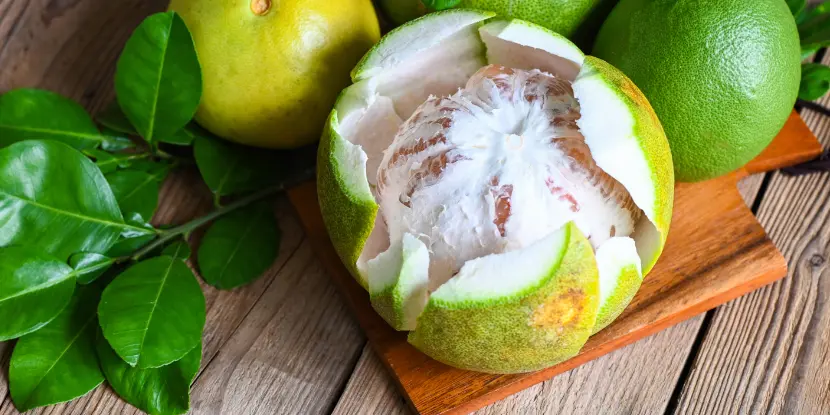
The pomelo is a grapefruit on steroids – thicker rind, larger size, and more sweetness.
At-a-Glance
- Light: Full sun
- Temperatures: 65–85°; can tolerate brief drops to around 30°F (-1°C)
- Soil: Well-drained, loamy soil with a pH between 6.0 and 7.5
- Fruit Bearing Season: late fall to early spring; peak harvest between November and February
- Height: 15–50 ft
- Spread: 12–18 ft
Care
- Water young pomelo trees regularly to establish roots; water mature trees deeply during dry weather
- Apply a balanced citrus fertilizer in late winter and again in early spring
- Prune annually during late winter or early spring to remove dead or diseased branches and to shape the tree
- Regularly inspect for pests like aphids, mealybugs, and scale insects
FAQs: Growing Fruit Trees in Southern California
Q: Do I need separate pollinator trees for all fruit trees?
Not always. Some trees, like citrus, are self-pollinating, while others, such as apples, benefit from having a companion tree for better yields.
Q: How often should I water my trees?
Water newly planted trees weekly. Depending on the season, mature trees require deep watering every 1–3 weeks.
Q: What are low-chill hour varieties?
Low-chill hour varieties are bred to thrive in warmer climates, requiring fewer cold winter hours to flower and fruit.
Q: Can I plant my trees in pots?
Yes! Trees like lemons, limes, and figs adapt well to containers. Use large pots and ensure good drainage.
Q: What’s the best time of year to plant fruit trees?
Early spring or late winter is ideal for most fruit trees.
Q: How do I prevent common pests?
Use insecticidal soaps, neem oil, or beneficial insects like ladybugs to manage pests naturally.
Q: Do fruit trees need fertilizers?
Yes, especially during flowering and fruiting. Use balanced fertilizers or those formulated for fruit trees.
Q: How long before my tree produces fruit?
It varies by tree type. Some, like peaches, bear fruit in 1–2 years, while avocados may take up to 4–5 years.

